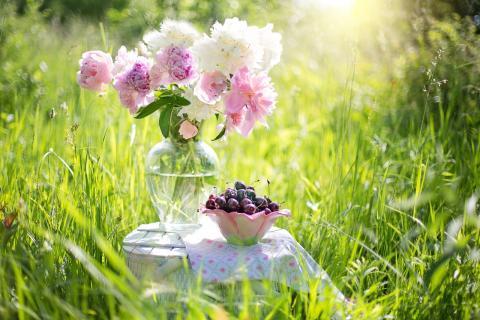
For many, spring doesn’t come until the first flowers have bloomed—crocuses that line sidewalks, daffodils that spring up in patches next to highways, and hyacinth that bloom in delicately planted containers—but my favorite way to bring spring inside is with a fresh bouquet. Flowers inside the home are more than just pretty. One study looked at the effects of flowers and foliage in the rooms of recovering hospital patients; patients with bouquets and plants had positive physiological responses, lower heart rates, lower systolic blood pressure, and lower ratings of pain fatigue than those without the flowers and foliage. A 2004 study documented a link between seeing plants and task efficiency and creativity, while yet another study demonstrated that interaction with indoor plants reduces psychological and physiological stress.
Setting the Mood
Of course, most people purchase bouquets to brighten up a kitchen or give to a friend or romantic partner. Beyond smelling good, the colors you choose can affect your mood. Lacking energy? Try bright colors like yellow and orange. Craving peace and serenity? Blues and lilacs are helpful. Need passion? Red is always a solid bet. While color-coding your bouquets to find a mood is useful, thinking about colors in a broader sense can be helpful in ushering certain seasons. Summer flowers (and colors) tend to be bolder and brighter, while fall and winter flowers are pluck with burgundies, deep purples, and jade-colored greens. Meanwhile, spring flowers are often synonymous with Easter: think pale yellows, baby blues, cheerful pinks, and soft greens. Luckily, all of these can be cultivated in your backyard to make your own spring bouquet.
Cultivating Your Backyard Bouquets
Cultivating your own backyard bouquet is as simple as growing your own flowers…but for those lacking a green thumb, this can be harder than it sounds. Annuals are often too flimsy and small (think pansies or begonias) but perennial bulbs (like tulips or hyacinth) are hardy and tall enough to work in most bouquets. Simply choose your favorites (or mix and match a variety) from your local nursery and plant in the fall 5-8 inches deep depending on bulb size (the smaller, the shallower). Flowers should begin to sprout in early March in most regions, meaning that bouquets should be ready by early April, if not sooner. Forgot to plant your bulbs last fall? You can purchase pre-grown plants from most nurseries to save money and still have fun cutting your own.
Foraging Your Bouquet
Before we begin, there are some important rules to remember when foraging. First, practice the rule of thirds: pick one-third, leave one-third for the birds and bees, and leave the last one-third for the future. Additionally, never take flowers from neighbor’s gardens or public property. Lastly, never pick endangered or threatened wildflowers. However, many of the flowers listed below can be found growing wild thanks to bulbs and seeds that are accidentally spread:
- Lilacs
- Daffodils
- Flowering quince
- Peonies
- Hyacinth
- Freesias
- Sweet peas
- Tulips
Mix and match spring flowers with various foliage to further brighten your bouquet. I often like taking a few of the leaves of the flower I’m picking (for example, lilac leaves offer a pretty chartreuse color).
Once collected, be sure to evenly cut the bottoms to best fit in your vase and fill with cold water. Picking flowers that haven’t quite bloomed often means that you can enjoy the flower once it’s home in your vase a little longer. Change the water every day to ensure the flowers last, in addition to keeping the smell down (nothing smells worse than rotting bouquets.)
What are your favorite spring bouquets? Do you grow your own or forage wild flowers? Let us know in the comments below!








